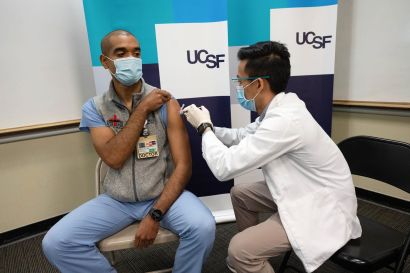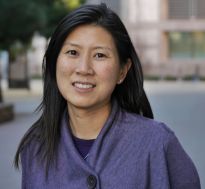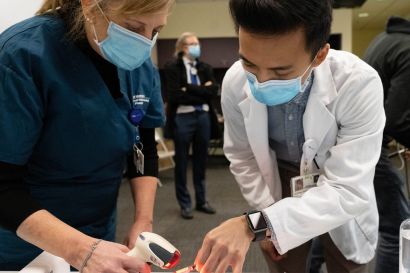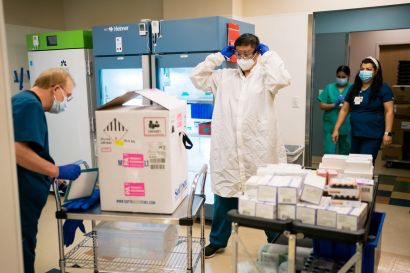- About
- Organization
- Organization Overview
- Dean’s Office
- Department of Bioengineering and Therapeutic Sciences
- Department of Clinical Pharmacy
- Department of Pharmaceutical Chemistry
- Quantitative Biosciences Institute
- Org Chart
- Research
- Education
- Patient Care
- People
- News
- Events
Frontline Pharmacy: Rising to the Moment
By Suzan Revah / Tue Mar 11, 2025

Susan Merrell
Tomas Diaz, a clinical fellow in the UCSF Department of Emergency Medicine, gets a COVID-19 shot from Matthew Aludino, a fourth-year student in the School of Pharmacy.
As COVID-19 cases began rising in San Francisco, UCSF Health braced for impact. Among the first to respond was UCSF School of Pharmacy professor Katherine Yang, PharmD, MPH, an infectious disease expert. Yang had closely tracked the virus’s rapid spread and severe impact, and when the first patients arrived at UCSF Medical Center, she knew she had to act quickly.
UCSF Health was among the earliest health systems to offer remdesivir, the first antiviral to show promise against COVID-19. Yang led the pharmacy effort to secure and rapidly deploy new therapeutics at UCSF. She worked with public health and pharmacy leaders nationwide, sharing protocols and best practices as new therapies emerged and to promote equitable access.

Katherine Yang, PharmD, MPH
Over the course of the pandemic, UCSF deployed 10 different drugs for post-exposure prophylaxis (PEP), pre-exposure prophylaxis (PrEP) and treatment of COVID, which included a “one-stop shop” drive-through vaccine and a monoclonal antibody clinic.
“COVID showed us that what we had to do is talk to each other, and not just within our institution,” said Yang. “Because the health of the community doesn’t mean the health of the UCSF community. It means the health of everyone.”
Vaccinating the frontline — and beyond
By December 2020, the arrival of the first COVID-19 vaccines brought hope. UCSF Health vaccinated thousands of frontline workers, which involved prioritizing and coordinating limited and sporadic supply.
UCSF Health’s VP chief pharmacy executive, Desi Kotis, PharmD, remembers being on a Zoom call and virtually raising her hand to lead the charge to figure out unprecedented logistical challenges.
“By early October, we knew we needed to get ready, but we didn’t know how to start the process,” said Kotis, who is vice dean of clinical affairs at the UCSF School of Pharmacy. “I thought, ‘How about if we really show our capabilities as pharmacists?’”

Lisa Kroon, PharmD
Kotis worked closely with Lisa Kroon, PharmD, professor in the school and now UCSF Health’s assistant chief pharmacy officer for clinical innovation, education and research, to organize what Kotis described as makeshift pharmacies run by a village of volunteers. Kroon said students were eager to support the effort along with their preceptors, which enabled the first delivery of vaccines to be administered within hours of being received.
Collaboration and continuous learning

Susan Merrell
Alexandra Hilts-Horeczko (left), PharmD, and Matthew Aludino, a fourth-year student in the School of Pharmacy, prepare a COVID-19 vaccine at the clinic offering the first inoculations for front-line UCSF workers on Dec. 16.
Eventually, a COVID-19 vaccine standard operating procedure manual was developed by UCSF Health pharmacy leaders, a 100-plus-page document that detailed how to open high-efficiency vaccination clinics at UCSF and across the Bay Area without compromising safety. Continuous learning became business as usual as the all-hands-on-deck vaccination efforts continued, throughout new phases of the pandemic that brought new vaccines and new treatments.
“Very early on in the pandemic, our pharmacy team was making sure we had enough drug supply so if we got a surge, we could handle it. That included ordering everything we could think of that might work,” said Yang, adding that an ethics committee was established to address triage during medication shortages and to ensure that no drug was being hoarded.
One of the team’s significant findings came early in the vaccine rollout. UCSF pharmacists discovered they could extract an extra dose from each vial of vaccine, which meant thousands more people could be vaccinated with the same supply.
“We were working at the top of our license, and became the experts on the vaccines,” added Kotis, who answered media inquiries from around the country. “It was really important as a clinician, as a professional and as a leader representing UCSF to get out there and be calm and to allay public fears.”
“Collaboration and transparency were really important, and if anybody needed something, we shared. There wasn’t a sense of ‘our patients’ and ‘your patients,’” said Yang.

Desi Kotis, PharmD
Kotis added that pharmacists are now much more prepared to triage with first responders, and now have many more emergency management tools that can be quickly deployed, whether the emergency is a natural disaster like an earthquake or fire, or another pandemic situation.
“There’s readiness as far as personal protective equipment.... We’ve learned a lot about distancing and hand-washing,” Kotis said. “We’ve also learned a lot when it comes to awareness. People still mask, and now you can buy at-home tests, and people stay home now when they have a cold. Everybody’s following bird flu now. Everybody is following what’s happening in Africa. So now we’re making sure we’re proactive with travelers and at all our borders.”
A lasting impact on pharmacy practice

The first doses of the Pfizer COVID-19 vaccine arrived at UC San Francisco on Dec. 16. 2020. Robinson Abueg (center), the UCSF Pharmacy receiving manager, prepares to unpack the FedEx box packed with dry ice and the vaccinations.
While the initial waves of COVID-19 subsided, the pandemic’s impact on pharmacy practice and pharmacy education is ongoing. UCSF pharmacists have taken on new responsibilities, including providing care through test-and treat clinics and managing monoclonal antibody treatments in clinics. Many of those roles have become permanent standards of pharmacy care and clinical practice that are being passed onto students at the School of Pharmacy.
“We prepare our doctor of pharmacy students to be key members of the health care team and public health efforts during a crisis,” Kroon said. “They get their immunization training in the first year, but we also instill in them the need to be lifelong learners, and to keep up with new studies, evidence and medications as they become available.”
Through partnerships with the city and state to limit COVID’s spread among vulnerable populations, testing and vaccination efforts connected patients to additional vaccines for flu and new outbreaks like mpox. These health prevention efforts also expanded to things like wound care and insulin and harm reduction, easing the burden on emergency rooms.
More
Series
COVID and Pharmacy, 5 Years Later
On March 11, 2020, when the World Health Organization declared COVID-19 a global pandemic, UCSF School of Pharmacy experts were already mobilizing to meet the crisis. What followed was next-level collaboration across pharmacy, patient care and research.
From securing emergency treatments to leading mass vaccination efforts, UCSF pharmacists reconfigured workflows and expanded their clinical scope to ensure fast, equitable access to care, an effort that redefined public perceptions of the pharmacy profession and continues to shape health care globally. Meanwhile, the school’s scientists led essential research that deepened our understanding of COVID and drove therapeutic innovations to combat the virus.
| Tue Mar 11, 2025 | Decoding COVID-19: QBI Researchers Pave the Way for New Drug Discoveries to Combat Virus |
| Tue Mar 11, 2025 |
This page: Frontline Pharmacy: Rising to the Moment |
| Tue Mar 11, 2025 | Q&A with Marilyn Stebbins, PharmD: Pharmacy Advocate and COVID-19 Patient Zero |
| Tue Mar 11, 2025 | Lessons Learned: Five Years of COVID-19 Research and Response at UCSF |
Tags
Topics:
Category:
Sites:
School of Pharmacy, Department of Clinical Pharmacy, PharmD Degree Program
About the School: The UCSF School of Pharmacy aims to solve the most pressing health care problems and strives to ensure that each patient receives the safest, most effective treatments. Our discoveries seed the development of novel therapies, and our researchers consistently lead the nation in NIH funding. The School’s doctor of pharmacy (PharmD) degree program, with its unique emphasis on scientific thinking, prepares students to be critical thinkers and leaders in their field.






